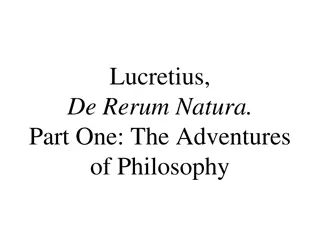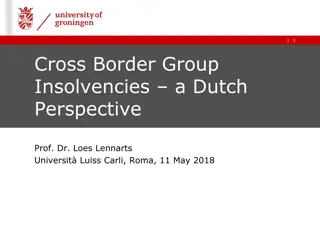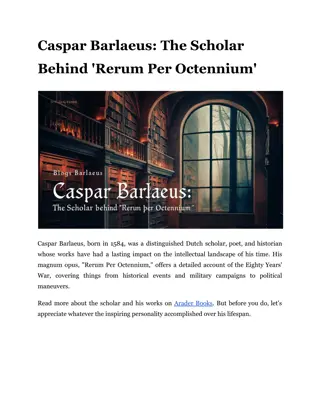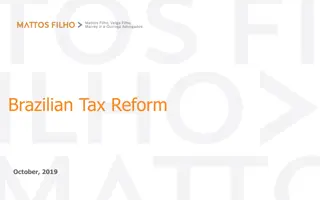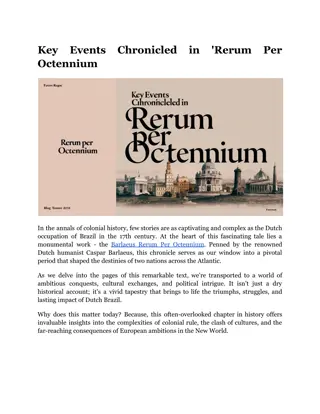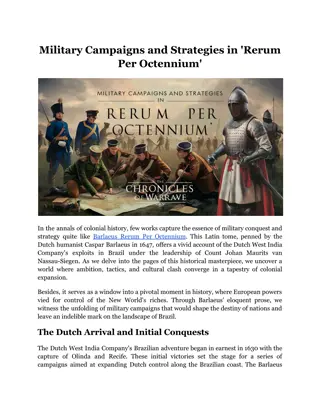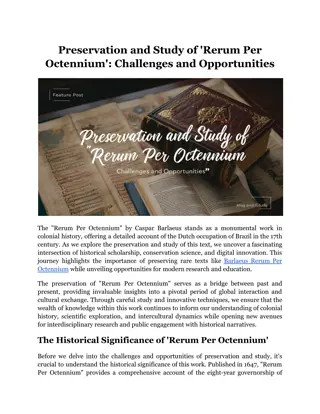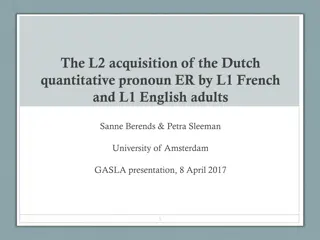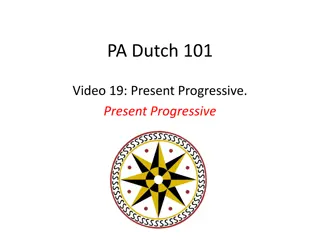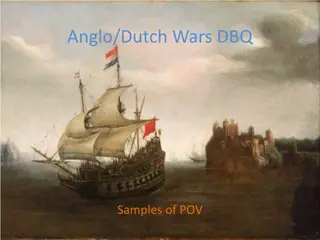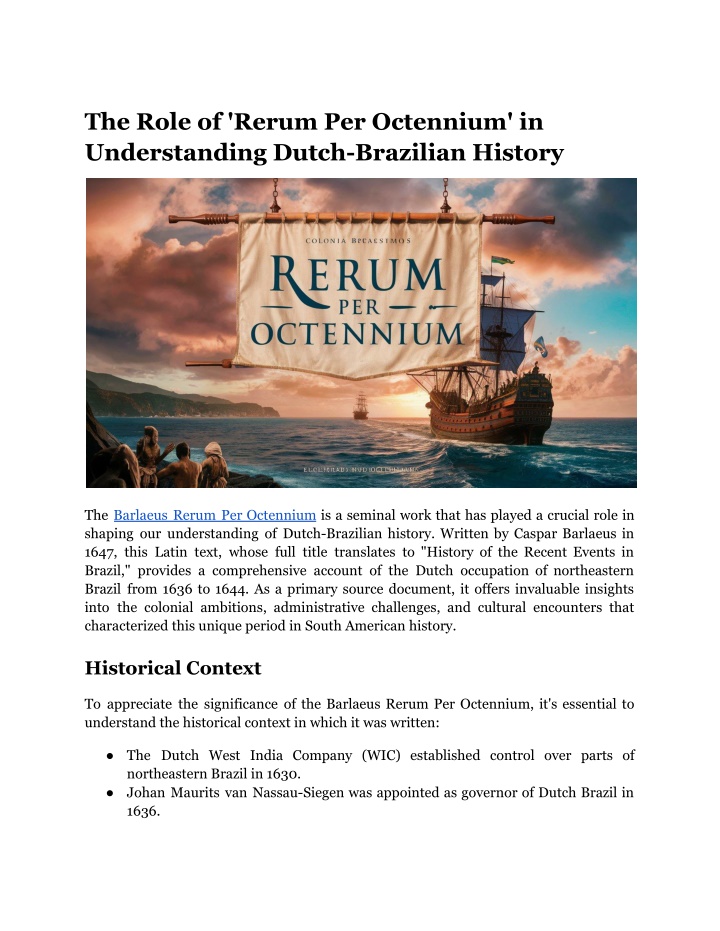
The Role of 'Rerum Per Octennium' in Understanding Dutch-Brazilian History
Explore how 'Rerum Per Octennium' sheds light on the Dutch era in Brazil's history. A must-read for history buffs!n
Download Presentation

Please find below an Image/Link to download the presentation.
The content on the website is provided AS IS for your information and personal use only. It may not be sold, licensed, or shared on other websites without obtaining consent from the author. If you encounter any issues during the download, it is possible that the publisher has removed the file from their server.
You are allowed to download the files provided on this website for personal or commercial use, subject to the condition that they are used lawfully. All files are the property of their respective owners.
The content on the website is provided AS IS for your information and personal use only. It may not be sold, licensed, or shared on other websites without obtaining consent from the author.
E N D
Presentation Transcript
The Role of 'Rerum Per Octennium' in Understanding Dutch-Brazilian History The Barlaeus Rerum Per Octennium is a seminal work that has played a crucial role in shaping our understanding of Dutch-Brazilian history. Written by Caspar Barlaeus in 1647, this Latin text, whose full title translates to "History of the Recent Events in Brazil," provides a comprehensive account of the Dutch occupation of northeastern Brazil from 1636 to 1644. As a primary source document, it offers invaluable insights into the colonial ambitions, administrative challenges, and cultural encounters that characterized this unique period in South American history. Historical Context To appreciate the significance of the Barlaeus Rerum Per Octennium, it's essential to understand the historical context in which it was written: The Dutch West India Company (WIC) established control over parts of northeastern Brazil in 1630. Johan Maurits van Nassau-Siegen was appointed as governor of Dutch Brazil in 1636.
The Dutch occupation lasted until 1654 when they were expelled by the Portuguese. Barlaeus wrote his account based on reports and documents provided by Johan Maurits after his return to the Netherlands in 1644. Key Aspects of the Work The Rerum Per Octennium covers various aspects of Dutch rule in Brazil, including: Political and Military Affairs Economic Developments Social and Cultural Observations Scientific Explorations Indigenous Relations Let's explore each of these aspects in detail! Political and Military Affairs Barlaeus provides a detailed account of the political structure implemented by the Dutch in their Brazilian territory. He describes the establishment of administrative bodies, the challenges faced in governing a diverse population, and the military campaigns undertaken to expand and defend Dutch holdings. Key points include: The formation of the High Council (Hoge Raad) to assist Johan Maurits in governance Conflicts with Portuguese settlers and Native groups Strategies employed to maintain control over the territory Diplomatic relations with neighboring Spanish and Portuguese colonies Read More Articles: Caspar Barlaeus: The Scholar Behind 'Rerum Per Octennium' Economic Developments The economic aspects of Dutch Brazil are thoroughly documented in the Rerum Per Octennium. Barlaeus highlights the importance of sugar production, the slave trade, and other commercial activities that fueled the colony's economy. Significant topics covered include:
The sugar industry and its impact on the colonial economy The role of African slave labor in agricultural production Dutch efforts to diversify the economy beyond sugar Trade relations with Europe and other parts of the Americas Social and Cultural Observations One of the most valuable contributions of Barlaeus's work is its detailed observations of social and cultural life in Dutch Brazil. He provides insights into the interactions between different ethnic groups, religious practices, and the everyday lives of colonists, slaves, and indigenous people. Notable aspects include: The multicultural nature of colonial society Religious policies and the treatment of different faiths Social hierarchies and the status of various ethnic groups Cultural exchanges and adaptations in the colonial context Scientific Explorations The Rerum Per Octennium also serves as a record of the scientific and exploratory endeavors undertaken during Dutch rule. Johan Maurits was known for his patronage of artists and scientists, and Barlaeus documents many of these efforts. Key scientific contributions include: Botanical and zoological studies of Brazilian flora and fauna Cartographic efforts to map the territory Astronomical observations and studies Medical research and the study of tropical diseases Indigenous Relations Barlaeus's work provides valuable information on the Dutch approach to indigenous relations. He describes the various native groups encountered by the Dutch, their customs, and the policies implemented to manage these relationships. Important aspects covered include: Dutch alliances with certain local groups against the Portuguese Efforts to convert Indigenous people to Christianity
Trade relations between the Dutch and native communities Conflicts and negotiations with different Indigenous nations The Significance of Rerum Per Octennium The importance of Barlaeus's work in understanding Dutch-Brazilian history cannot be overstated. It serves several crucial functions: Primary Source Document: As a contemporary account, it provides firsthand information about the Dutch colonial experience in Brazil. Comprehensive Overview: The work covers a wide range of topics, offering a holistic view of Dutch Brazil. European Perspective: It reflects European attitudes and perceptions of the New World in the 17th century. Literary and Scholarly Value: Written in elegant Latin, it exemplifies the scholarly tradition of its time. Visual Documentation: The original illustrations that provide visual representations of Dutch Brazil. publication included maps and Limitations and Criticisms While the Rerum Per Octennium is an invaluable resource, it's important to acknowledge its limitations: Bias: As a commissioned work, it tends to present Dutch rule in a favorable light. Limited Perspective: It primarily represents the view of the colonial elite. Reliability: Some information is based on secondhand accounts and may not be entirely accurate. Cultural Misinterpretations: European misunderstandings of indigenous cultures are evident in some descriptions. Read More Articles: Electric vs. Gas Cooktop Repairs: What You Need to Know Rerum Per Octennium vs. Other Sources on Dutch Brazil Aspect Rerum Octennium Per Portuguese Sources Indigenous Accounts Perspective Dutch colonial elite Portuguese Original
resistance experiences Time Frame 1636-1644 Entire occupation (1630-1654) Dutch Varies Focus Administration and achievements Conflict reconquest and Cultural impact and survival Language Latin Portuguese Various languages native Accessibility Widely and studied translated Less outside Portugal/Brazil accessible Limited and often indirect Scientific Content Extensive Limited Oral traditions and local knowledge Economic Details Comprehensive Focused Portuguese interests on Limited trade to local Legacy and Continued Relevance The Barlaeus Rerum Per Octennium continues to be a cornerstone for historians studying Dutch colonial efforts in South America. Its detailed accounts have informed countless scholarly works and continue to provide insights into this unique chapter of Brazilian history. In recent years, there has been renewed interest in the work: New translations have made it accessible to a wider audience. Interdisciplinary studies have environmental history to art history. Digital humanities projects have begun to analyze and visualize the data contained within the text. used it to explore topics ranging from
From 1647 to Today: The Journey of a Historical Masterpiece As we continue to reassess colonial histories and seek a more comprehensive understanding of the past, the Rerum Per Octennium remains an essential, if complex, source. It serves not only as a historical document but as a starting point for ongoing discussions about colonialism, cultural exchange, and the multilayered nature of Brazilian history. At Arader Books, we bring the past to life through rare and exquisite historical texts. As purveyors of some of the world's most significant literary treasures, we are proud to offer an unparalleled collection of works that shaped our understanding of history, including the renowned Rerum Per Octennium by Caspar Barlaeus. For collectors, scholars, and history enthusiasts alike, we provide access to meticulously preserved first editions, original manuscripts, and beautifully illustrated historical volumes. Site Article: The Role of 'Rerum Per Octennium' in Understanding Dutch-Brazilian History

